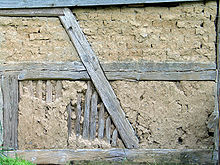Compartment
A compartment is part of a wall of a half-timbered house and describes the space between the wooden beams. The filling of the compartment is also referred to as infill .
Infill
Truss infills were carried out in different ways depending on the period, region and availability of the material:
- Fair-faced masonry made of bricks , facing bricks or clinker bricks , rarely also with adobe bricks in outbuildings
- Plastered walling with bricks , adobe , quarry stone or aerated concrete
- Regionally limited, e.g. B. in the Bönninghardt on the Lower Rhine, grass was used to fill the compartments
-
Clamping the box by first knocking grooves in the top and bottom edges of the horizontal beams. The grooves are either
- vertical stakes are pushed, which are braided with willow rods and covered with clay , or
- the Stakhölzer be wrapped, then first with a straw-clay mixture as Weller timber pushed into the grooves and, finally, a smooth surface is a Lehmverstrich ( loam ) was prepared.
When erecting and renovating walls that contain less pressure-resistant building materials such as wood, clay, light bricks, sandstone and aerated concrete, only elastic plastering and masonry mortars , which also have a low compressive strength , should generally be used . These are primarily clay and air lime mortars , as well as lime mortars with small proportions of hydraulically setting binders . This is particularly true for half-timbered structures, where every driving rain leads to moisture penetration and, as a result of swelling and subsequent shrinking, of the wooden beams.
Bricks
Brick infills are usually made as exposed masonry . In some regions, the infill is also provided with a lime plaster .
The bricks are walled up with clay or lime mortar and grouted with lime mortar. Due to its moisture-regulating effect, clay has a preserving effect on the timber of the framework. The final moisture content of clay is lower than that of wood, so the clay ensures that the wood remains dry and does not rot. In addition, the stones can be easily cleaned of mortar residues during renovation work and reused.
For stabilization, notches are made in the uprights of the half-timbered wall so that there is a form-fitting connection between the mortar and the wood. Alternatively, when renovating old half-timbered buildings, triangular strips are nailed to the studs or galvanized nails are hammered into the studs at joint height. Since mortar and wood lose some of their volume when they dry, the brickwork could otherwise stand loosely in the compartment.
Mud bricks
Infills with earth bricks are most often found on interior walls and commercial or servant buildings . A clay or lime plaster is applied over it. As with the brick infill, the wooden posts are notched.
Clay stick

The clay stick is an elongated piece of split wood of different cross-section. It is clamped vertically between the horizontal truss beams. These are therefore referred to as timber .
To anchor the clay pegs, small holes are made in the underside of the upper beam , the latch , and a groove in the top of the lower beam, e.g. B. a threshold , beaten - or a groove attached to the top and bottom of the beams. The tool used for this is the Dexel .
The stakes are then pelted with straw clay in several layers (clay plaster ) and then plastered . In some regions, Punting before the grout is still a wickerwork from willow - wrapped or hazel branches, specialist rods called.
Plaster
In order to avoid damage to the framework outdoors, when plastering it must be ensured that the plaster is flush with the wood or that it jumps back slightly. Only diffusion-open materials should be used as plaster . Plasters made from highly hydraulic lime or even cement can damage the framework.
When using clay as an external plaster, it must also be protected against weathering . A coat of 1 part sump lime , 1/4 quark and 1/8 linseed oil is suitable for this . This coating turns pure white after drying and protects the clay for many years.
When renovating old half-timbered buildings, some craftsmen apply special plaster to the outermost plaster layer of the compartments. In addition to limestone powder, these contain aggregates of ground bricks , sand and a little cement. The mixture is a soft plaster that should behave like the clay underneath when there are temperature fluctuations.
Historical plasters and paints
Jakob Ignaz Hittorff already dealt with the multicolor of historical buildings at the beginning of the 19th century , but it has only recently been systematically investigated in monument conservation . The colors of the shelf include, for example, red and gray-green ocher. The bars were, among others, red, yellow, gray or black in focus . Different layers of paint are often on top of each other.
literature
- Josef Maier: Predefined crack system? Practical building examples: color and half-timbering. In: The painter and master varnisher. No. 3, 2001 ( PDF ; 493 kB).
- Johannes Cramer : On the exterior color of noble country estates of the 16th and 17th centuries in southwest Germany. In: Castles and Palaces . Volume 29, No. 2, 1988, pp. 102-108, doi: 10.11588 / bus.1988.2.41834 .
- Johannes Cramer: Color in half-timbered buildings - Findings from southern Germany. Deutscher Kunstverlag, Munich 1990, ISBN 3-422-06056-1 (Zugl .: Hannover, Univ., Habil.-Schr., 1987).
- Wolfgang Lenze: Half-timbered houses, restore - renovate - modernize. 3rd, exp. Edition. Fraunhofer IRB Verlag, Stuttgart 2004, ISBN 3-8167-6431-2 .


